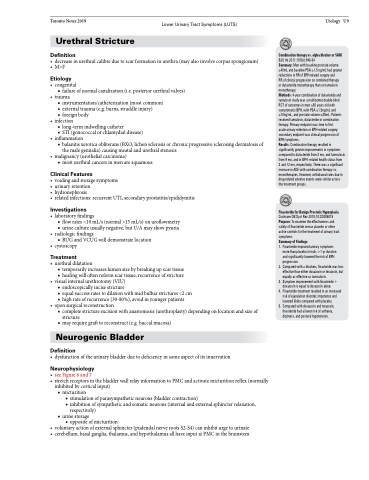Page 1327 - TNFlipTest
P. 1327
Toronto Notes 2019 Lower Urinary Tract Symptoms (LUTS) Urethral Stricture
Definition
• decreaseinurethralcalibreduetoscarformationinurethra(mayalsoinvolvecorpusspongiosum) • M>F
Etiology
• congenital
■ failure of normal canalization (i.e. posterior urethral valves)
• trauma
■ instrumentation/catheterization (most common) ■ external trauma (e.g. burns, straddle injury)
■ foreignbody
• infection
■ long-termindwellingcatheter
■ STI (gonococcal or chlamydial disease)
• inflammation
■ balanitis xerotica obliterans (BXO; lichen sclerosis or chronic progressive sclerosing dermatosis of
the male genitalia) causing meatal and urethral stenosis • malignancy(urothelialcarcinoma)
■ most urethral cancers in men are squamous
Clinical Features
• voidingandstoragesymptoms
• urinaryretention
• hydronephrosis
• relatedinfections:recurrentUTI,secondaryprostatitis/epididymitis
Investigations
• laboratoryfindings
■ flow rates <10 mL/s (normal >15 mL/s) on uroflowmetry ■ urine culture usually negative, but U/A may show pyuria
• radiologicfindings
■ RUG and VCUG will demonstrate location
• cystoscopy
Treatment
• urethraldilatation
■ temporarily increases lumen size by breaking up scar tissue ■ healing will often reform scar tissue, recurrence of stricture
• visualinternalurethrotomy(VIU)
■ endoscopically incise stricture
■ equal success rates to dilation with mid bulbar strictures <2 cm ■ high rate of recurrence (30-80%), avoid in younger patients
• opensurgicalreconstruction
■ complete stricture excision with anastomosis (urethroplasty) depending on location and size of
stricture
■ may require graft to reconstruct (e.g. buccal mucosa)
Neurogenic Bladder
Definition
• dysfunctionoftheurinarybladderduetodeficiencyinsomeaspectofitsinnervation
Neurophysiology
• seeFigure6and7
• stretchreceptorsinthebladderwallrelayinformationtoPMCandactivatemicturitionreflex(normally
inhibited by cortical input) ■ micturition
◆ stimulation of parasympathetic neurons (bladder contraction)
◆ inhibition of sympathetic and somatic neurons (internal and external sphincter relaxation,
respectively) ■ urine storage
◆ opposite of micturition
• voluntaryactionofexternalsphincter(pudendalnerverootsS2-S4)caninhibiturgetourinate
• cerebellum,basalganglia,thalamus,andhypothalamusallhaveinputatPMCinthebrainstem
Urology U9
Combination therapy vs. alpha blocker or 5ARI
BJU Int 2011:107(6):946-54
Summary: Men with baseline prostate volume ≥40mL and baseline PSA ≥1.5 ng/mL had greater reductions in RR of BPH-related surgery and
RR of clinical progression on combined therapy
or dutasteride monotherapy than on tamulosin monotherapy.
Methods: 4-year combination of dutasteride and tamulosin study was a multicentre double-blind RCT of outcomes in men ≥50 years old with symptomatic BPH, with PSA ≥1.5ng/mL and ≤10ng/mL, and prostate volume ≤30mL. Patients received tamulosin, dutasteride or combination therapy. Primary endpoint was time to first
acute urinary retention or BPH-related surgery; secondary endpoint was clinical progression of BPH/symptoms.
Results: Combination therapy resulted in significantly greater improvements in symptoms compared to dutasteride from 3 mo, and tamsulosin from 9 mo, and in BPH- related health status from 3 and 12 mo, respectively. There was a significant increase in ADE with combination therapy vs. monotherapies. However, withdrawal rates due to drug-related adverse events were similar across the treatment groups.
Finasteride for Benign Prostatic Hyperplasia
Cochrane DB Syst Rev 2010;10:CD006015 Purpose: To examine the effectiveness and safety of finasteride versus placebo or other active controls for the treatment of urinary tract symptoms.
Summary of Findings:
1. Finasteride improved urinary symptoms
more than placebo in trails >1 yr duration and significantly lowered the risk of BPH progression.
2. Comparedwithα-blockers,finasteridewasless effective than either doxazosin or terazosin, but equally as effective as tamsulosin.
3. Symptom improvement with finasteride + doxazosin is equal to doxazosin alone.
4. Finasteridetreatmentresultedinanincreased risk of ejaculation disorder, impotence and lowered libido compared with placebo.
5. Compared with doxazosin and terazosin, finasteride had a lower risk of asthenia, dizziness, and postural hypotension.


